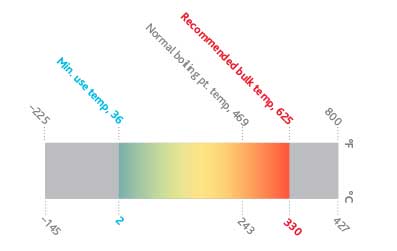Just how to Pick the Best Heat Transfer Fluid for Industrial Applications
Why Warmth Transfer Liquid Is Very Important for Optimizing Power Transfer in Systems
The role of heat transfer liquids in maximizing power transfer is crucial for accomplishing effective thermal monitoring across different commercial industries. These liquids promote seamless heat exchange, making sure procedures run within optimum temperature level varieties and reducing the threat of getting too hot.

Role in Thermal Administration
Heat transfer liquids play an important function in thermal monitoring by successfully controling temperature levels in numerous commercial processes and systems. These specialized fluids promote the transfer of warm between different elements, guaranteeing optimum operating problems and avoiding getting too hot. By preserving precise temperature control, warm transfer liquids enable markets such as chemical manufacturing, oil and gas, and power generation to operate safely and efficiently.
The option of a suitable heat transfer liquid depends on a number of variables, consisting of thermal security, warm ability, and viscosity. High thermal security guarantees that the liquid can withstand severe temperature levels without weakening, while a high warmth capability allows it to absorb and launch considerable amounts of warmth - heat transfer fluid. Low thickness lowers the power required for pumping, adding to total system effectiveness
In addition, warmth transfer liquids are essential in applications like refrigeration, where they assist soak up and dissipate heat throughout the cooling cycle. In solar thermal energy systems, these fluids capture and transport solar heat to generate electricity or provide warm water. Their flexibility to diverse operating problems and capacity to maintain constant thermal performance underscore their relevance in commercial thermal monitoring, helping with operational connection and enhancing precaution.

Enhancing System Effectiveness
To make the most of the benefits of thermal monitoring, improving system efficiency with the calculated usage of heat transfer liquids is vital. By maintaining optimum temperature level levels, heat transfer liquids assist ensure that systems operate within their designed criteria, thus stopping getting too hot and minimizing the threat of component failing.

Sorts Of Warmth Transfer Liquids
The diversity of warm transfer liquids highlights their crucial function in a series of industrial applications, each customized to fulfill certain thermal administration requirements. These fluids facilitate efficient energy transfer and are picked based on crucial residential or commercial properties such as thermal stability, viscosity, and heat capability. The primary types include water, glycol remedies, oils, and synthetics, each offering unique benefits.
Water is the most usual heat transfer medium as a result of its high specific warmth capability and reduced cost. Nevertheless, its usage is limited by its freezing and steaming points. Glycol combinations, frequently used in cooling and heating systems, supply a lower freezing point, including versatility in various environments. Mineral have a peek at this site oils are favored for their thermal security and non-corrosive nature, making them suitable for high-temperature applications.

Artificial fluids, consisting of silicone and fragrant substances, offer remarkable thermal security and are utilized in atmospheres requiring severe temperature level ranges. These liquids make certain superior performance in systems where typical liquids may stop working. The selection of a warmth transfer liquid is vital, as it influences system effectiveness, security, and long life. Each type has to be picked to align with the functional demands and the specific problems of the application it serves.
Environmental and Economic Conveniences
Using the right warm transfer liquids supplies substantial environmental and financial benefits for commercial procedures. By picking liquids with exceptional thermal stability and high warm ability, sectors can boost power performance, resulting in decreased gas intake and lower greenhouse gas emissions. This contributes to a smaller carbon footprint and straightens with worldwide sustainability goals. Eco-friendly warmth transfer liquids, usually naturally degradable and non-toxic, reduce the risk of dirt and water contamination in the event of leakages or spills, thereby securing environments and abiding by rigorous environmental guidelines.
Economically, the appropriate warmth transfer fluid can considerably reduce functional expenses. Fluids with extended lifecycle performance decrease the regularity of replacements and upkeep, decreasing downtime and associated expenses. In general, the calculated usage of optimal warm transfer liquids my latest blog post supports lasting financial development and ecological stewardship.
Selecting the Right Fluid
Exactly how does one navigate the complex procedure of choosing the appropriate warm transfer liquid for industrial applications? Selecting the proper fluid is important, as it straight affects system efficiency, security, and functional prices. Trick considerations consist of thermal stability, compatibility with system materials, and running temperature level variety. Thermal stability guarantees the fluid can endure high temperatures without weakening, while compatibility protects against deterioration or other destructive reactions with system elements. The operating temperature variety should line up with the system's requirements to keep efficiency and longevity - heat transfer fluid.
Additionally, the fluid's heat ability and go to my site thickness are critical. A high warmth ability permits the liquid to absorb and move more energy, improving performance.
Verdict
The critical selection and application of heat transfer fluids are basic to enhancing energy transfer throughout numerous systems. By making certain high thermal stability and capability, these liquids give precise temperature control and enhance total system performance. This optimization adds to reduced functional expenses and lower greenhouse gas exhausts, hence promoting sustainability. The option of fluid, tailored to specific thickness and functional demands, is essential for taking full advantage of performance and achieving economic and environmental benefits in commercial procedures.